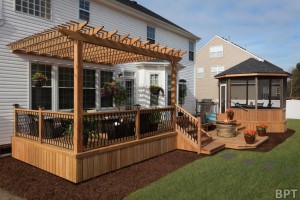 (BPT) – A wood deck is one of the best investments a homeowner can make.
(BPT) – A wood deck is one of the best investments a homeowner can make.
As the seasons turn, more homeowners look for projects that not only make their homes more livable, but also offer great return on investment. With demand high across the country for outdoor spaces that bring the comforts of the indoors outside, there’s no surprise that decks are one of the top remodeling projects for 2014.
In fact, a residential wood deck addition has a recouped cost of 87.4 percent, according to Remodeling Magazine’s 2014 Cost vs. Value Report, the second highest ROI midrange project only behind an entry door replacement. That means adding a deck to your property will increase your livable space so you can enjoy the outdoors more, and you can rest easy knowing you’re boosting the value of your home investment.
If you think you’d like to add a wood deck to your home, you might wonder about the different material options. “Although composite and PVC decking have gained popularity in recent years, pressure-treated wood decking still carries the lion’s share of the market because it’s inexpensive, easy to work with and can be found at any lumberyard,” says Chris Fox, product manager at Universal Forest Products, a leading supplier of lumber and decking materials.
Today’s pressure-treated lumber comes with advancements that weren’t available to homeowners just a few years ago. For example, with more homeowners seeking eco-friendly building materials, wood suppliers are exploring environmentally preferred treatment methods. For example, ProWood’s micronized copper azole (MCA) treated lumber decking is eco-friendly, cost effective and easy to install.
MCA is a method for treating the wood (typically pine) using an EPA-registered waterborne wood preservative system to protect against termite attack and rot. MCA-treated lumber provides a light, natural look, unlike other pressurized wood treatments that result in the greenish hue with which most people are familiar.
You can leave MCA treated lumber in its natural state for a more organic appearance in your outdoor spaces, or you can choose ProWood Dura Color decking that is color-infused with pigment driven deep into the wood fibers. This process creates beautiful treated wood grain that will stand up to the elements for many years, with no need for staining.
“People like the natural look of redwood and cedar, but they don’t want the drawbacks that come with them, such as the high price and the fact that they quickly fade to gray,” says Fox. “ProWood Dura Color lumber not only looks like natural cedar or redwood, but the color lasts much longer and is backed by a two-year color assurance warranty”
When researching treated wood materials for outdoor home improvement projects, such as a deck addition, Fox suggests discussing the project with the local lumber dealer and to be sure to understand and check the end tag for:
1. The description of use (above ground or ground contact)
2. Warranty statement
3. The quality standards it meets
4. Third-party quality inspection (which assures product has passed retention and penetration tests).
To learn more about the MCA process and get ideas about outdoor home improvement projects, visit www.prowoodlumber.com. Research proves a wood deck is a sound investment, and now with new eco-friendly decking materials, homeowners have more options than ever when it comes to improving their home’s exterior spaces.

